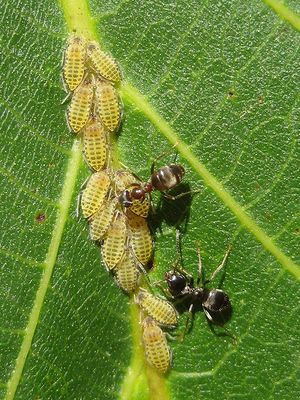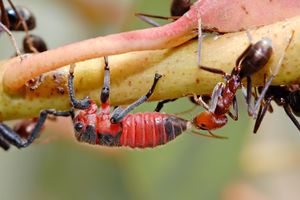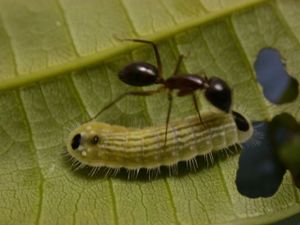حب النمل

حب النمل (Myrmecophily ؛ /mɜːrməˈkɒfɪli/ mur-mə-KOF-il-ee، التي تعني حرفياً "حب النمل") هو مصطلح يُطلق على positive interspecies associations between ants and a variety of other organisms such as plants, other arthropods, and fungi. Myrmecophily refers to mutualistic associations with ants, though in its more general use the term may also refer to commensal or even parasitic interactions.
The term myrmecophile is used mainly for animals that associate with ants. There are an estimated 10,000 species of ants (Formicidae), with a higher diversity in the tropics.[1] In most terrestrial ecosystems ants are ecologically and numerically dominant, being the main invertebrate predators. As a result, ants play a key role in controlling arthropod richness, abundance, and community structure.[2] There is evidence that the evolution of myrmecophilous interactions has contributed to the abundance and ecological success of ants,[1][3] by ensuring a dependable and energy-rich food supply and thus providing a competitive advantage for ants over other invertebrate predators.[4] Most myrmecophilous associations are opportunistic, unspecialized, and facultative (meaning both species are capable of surviving without the interaction), though obligate mutualisms (those in which one or both species are dependent on the interaction for survival) have also been observed for many species.[5]
محب النمل
A myrmecophile is an organism that lives in association with ants.
تفاعلات النمل-النبات
تفاعلات النمل-الحشرات
Hemiptera
Lycaenid butterflies
الخنافس الجوالة
مستويات متعددة من حب النمل
Significance of myrmecophily in ecology
Mutualisms are geographically ubiquitous, found in all organismic kingdoms, and play a major role in all ecosystems.[6][7] Combined with the fact that ants are one of the most dominant lifeforms on earth,[8] it is clear that myrmecophily plays a significant role in the evolution and ecology of diverse organisms, and in the community structure of many terrestrial ecosystems.
تطور التفاعلات الإيجابية
تعايش الأنواع
In addition to leading to coevolution, mutualisms also play an important role in structuring communities.[6] One of the most obvious ways in which myrmecophily influences community structure is by allowing for the coexistence of species which might otherwise be antagonists or competitors. For many myrmecophiles, engaging in ant associations is first and foremost a method of avoiding predation by ants. For example, the caterpillars of lycaenid butterflies are an ideal source of food for ants: they are slow-moving, soft-bodied, and highly nutritious, yet they have evolved complex structures to not only appease ant aggression but to elicit protective services from the ants.[2] In order to explain why ants cooperate with other species as opposed to preying on them, two related hypotheses have been proposed: cooperation either provides ants with resources that are otherwise difficult to find, or it ensures the long-term availability of those resources.[5]
بنية المجتمع
حب النمل كنظام نموذجي
Myrmecophilous interactions provide an important model system for exploring ecological and evolutionary questions regarding coevolution, plant defense theory, food web structure, species coexistence, and evolutionarily stable strategies. Because many myrmecophilous relationships are easily manipulable and tractable, they allow for testing and experimentation that may not be possible in other interactions. Therefore, they provide ideal model systems in which to explore the magnitude, dynamics, and frequency of mutualism in nature.[9]
انظر أيضاً
الهامش
- ^ أ ب B. Holldobler and E.O. Wilson, The Ants, Cambridge, Massachusetts: The Belknap Press of Harvard University Press, 1990.
- ^ أ ب K. Fiedler, B. Holldobler, and P. Seufert, "Butterflies and ants: The communicative domain," Cellular and molecular life sciences, vol. 52, 1996, pp. 14-24.
- ^ B. Holldobler and E.O. Wilson, Journey to the Ants, Cambridge, Massachusetts: The Belknap Press of Harvard University Press, 1994.
- ^ N. Bluthgen, N.E. Stork, and K. Fiedler, "Bottom-up control and co-occurrence in complex communities: honeydew and nectar determine a rainforest ant mosaic," Oikos, vol. 106, 2004, pp. 344-358.
- ^ أ ب B. Stadler and T. Dixon, Mutualism: Ants and their insect partners, Cambridge: Cambridge University Press, 2008.
- ^ أ ب خطأ استشهاد: وسم
<ref>غير صحيح؛ لا نص تم توفيره للمراجع المسماةjho - ^ M. Doebeli and N. Knowlton, "The evolution of interspecific mutualisms," Proceedings of the National Academy of Sciences of the United States of America, vol. 95, 1998, pp. 8676-8680.
- ^ خطأ استشهاد: وسم
<ref>غير صحيح؛ لا نص تم توفيره للمراجع المسماةvric - ^ خطأ استشهاد: وسم
<ref>غير صحيح؛ لا نص تم توفيره للمراجع المسماةheil


